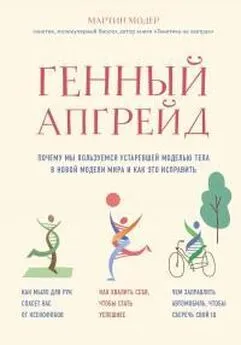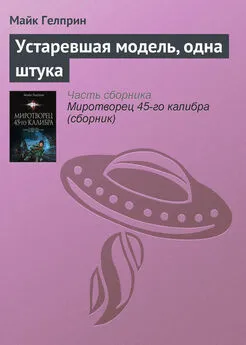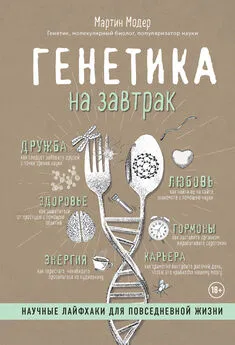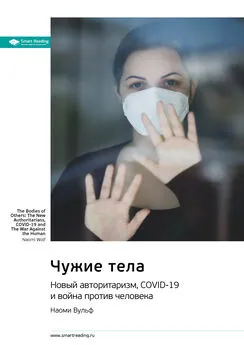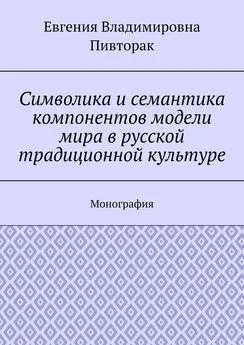Мартин Модер - Генный апгрейд. Почему мы пользуемся устаревшей моделью тела в новой модели мира и как это исправить
- Название:Генный апгрейд. Почему мы пользуемся устаревшей моделью тела в новой модели мира и как это исправить
- Автор:
- Жанр:
- Издательство:ООО «ЛитРес», www.litres.ru
- Год:2019
- ISBN:нет данных
- Рейтинг:
- Избранное:Добавить в избранное
-
Отзывы:
-
Ваша оценка:
Мартин Модер - Генный апгрейд. Почему мы пользуемся устаревшей моделью тела в новой модели мира и как это исправить краткое содержание
Генный апгрейд. Почему мы пользуемся устаревшей моделью тела в новой модели мира и как это исправить - читать онлайн бесплатно ознакомительный отрывок
Интервал:
Закладка:
Энергозатратная вспышка озарения
110. Bikson, M. et al., Safety of Transcranial Direct Current Stimulation: Evidence Based Update 2016. Brain Stimul. Basic Transl. Clin. Res. Neuromodulation 9, 641–661 (2016).
111. Clark, V. P. et al., TDCS Guided using fMRI Significantly Accelerates Learning to Identify Concealed Objects. Neuroimage 59, 117–128 (2012).
112. Coffman, B. A., Clark, V. P. & Parasuraman, R., Battery powered thought: enhancement of attention, learning, and memory in healthy adults using transcranial direct current stimulation. NeuroImage 85 Pt 3, 895–908 (2014).
113. Gooneratne, I. K. et al., Comparing neurostimulation technologies in refractory focal-onset epilepsy. J. Neurol. Neurosurg. Psychiatry 87, 1174–1182 (2016).
114. Kuo, M.-F. & Nitsche, M. A., Exploring prefrontal cortex functions in healthy humans by transcranial electrical stimulation. Neurosci. Bull. 31, 198–206 (2015).
115. Matsumoto, H. & Ugawa, Y., Adverse events of tDCS and tACS: A review. Clin.
116. Neurophysiol. Pract. 2, 19–25 (2017). Steenbergen, L. et al., ›Unfocus‹ on foc.us: commercial tDCS headset impairs working memory. Exp. Brain Res. 234, 637–643 (2016).
117. Tanaka, S., Hanakawa, T., Honda, M. & Watanabe, K., Enhancement of pinch force in the lower leg by anodal transcranial direct current stimulation. Exp.
118. Brain Res. Exp. Hirnforsch. Exp. Cerebrale 196, 459–465 (2009).
Красный свет для всезнаек
119. Barrett, D. W. & Gonzalez-Lima, F., Transcranial infrared laser stimulation produces beneficial cognitive and emotional effects in humans. Neuroscience 230, 13–23 (2013).
120. Gonzalez-Lima, F. & Barrett, D. W., Augmentation of cognitive brain functions with transcranial lasers. Front. Syst. Neurosci. 8, (2014).
121. Hamblin, M. R. & Demidova, T. N., Mechanisms of low level light therapy – an introduction. Proc SPIE, Vol 6140, art. no. 610011-12 (2006).
122. Karu, T. I., Pyatibrat, L. V., Kolyakov, S. F. & Afanasyeva, N. I., Absorption measurements of a cell monolayer relevant to phototherapy: reduction of cytochrome c oxidase under near IR radiation. J. Photochem. Photobiol. B 81, 98–106 (2005).
123. Michalikova, S., Ennaceur, A., van Rensburg, R. & Chazot, P. L., Emotional responses and memory performance of middle-aged CD1 mice in a 3D maze: effects of low infrared light. Neurobiol. Learn. Mem. 89, 480–488 (2008).
124. Mochizuki-Oda, N. et al., Effects of near-infra-red laser irradiation on adenosine triphosphate and adenosine diphosphate contents of rat brain tissue. Neurosci. Lett. 323, 207–210 (2002).
125. Pastore, D., Greco, M. & Passarella, S., Specific helium-neon laser sensitivity of the purified cytochrome c oxidase. Int. J. Radiat. Biol. 76, 863–870 (2000).
126. Rojas, J. C., Bruchey, A. K. & Gonzalez-Lima, F., Low-level light therapy improves cortical metabolic capacity and memory retention. J. Alzheimers Dis. JAD 32, 741–752 (2012).
127. Uozumi, Y. et al., Targeted increase in cerebral blood flow by transcranial near-infrared laser irradiation. Lasers Surg. Med. 42, 566–576 (2010).
128. Wang, X. et al., Up-regulation of cerebral cytochrome-c-oxidase and hemodynamics by transcranial infrared laser stimulation: A broadband near-infrared spectroscopy study. J. Cereb. Blood Flow Metab. Off. J. Int. Soc. Cereb. Blood Flow Metab. 37, 3789–3802 (2017).
129. Wong-Riley, M. T. T. et al., Photobiomodulation directly benefits primary neurons functionally inactivated by toxins: role of cytochrome c oxidase. J. Biol. Chem. 280, 4761–4771 (2005).
ГЛАВА 3. Биология человеческого поведения
130. Brasil-Neto, J. P., Pascual-Leone, A., Valls-Solé, J., Cohen, L. G. & Hallett, M., Focal transcranial magnetic stimulation and response bias in a forced-choice task. J. Neurol. Neurosurg. Psychiatry 55, 964–966 (1992).
131. Libet, B., Unconscious cerebral initiative and the role of conscious will in voluntary action. Behav. Brain Sci. 8, 529–539 (1985).
Чумовой пир на весь мир
Бессознательный страх перед инфекциями
132. Michel, J. F., Parasitological Significance of Bovine Grazing Behaviour. Nature 175, 1088–1089 (1955).
133. Rozin, P., Millman, L. & Nemeroff, C., Operation of the laws of sympathetic magic in disgust and other domains. J. Pers. Soc. Psychol. 50, 703–712 (1986).
Ненависть к чужакам и паразиты
134. Eskine, K. J., Kacinik, N. A. & Prinz, J. J., A bad taste in the mouth: gustatory disgust influences moral judgment. Psychol. Sci. 22, 295–299 (2011).
135. Faulkner, J., Schaller, M., Park, J. H. & Duncan, L. A., Evolved Disease-Avoidance Mechanisms and Contemporary Xenophobic Attitudes. Group Process. Intergroup Relat. 7, 333–353 (2004).
136. Fincher, C. L., Thornhill, R., Murray, D. R. & Schaller, M., Pathogen prevalence predicts human cross-cultural variability in individualism/collectivism. Proc. Biol. Sci. 275, 1279–1285 (2008).
137. Goodall, J., Social rejection, exclusion, and shunning among the Gombe chimpanzees. Ethol. Sociobiol. 7, 227–236 (1986).
138. Horberg, E. J., Oveis, C., Keltner, D. & Cohen, A. B., Disgust and the moralization of purity. J. Pers. Soc. Psychol. 97, 963–976 (2009).
139. Letendre, K., Fincher, C. L. & Thornhill, R., Does infectious disease cause global variation in the frequency of intrastate armed conflict and civil war? Biol. Rev. Camb. Philos. Soc. 85, 669–683 (2010).
140. Markel, H. & Stern, A. M., The Foreignness of Germs: The Persistent Association of Immigrants and Disease in American Society. Milbank Q. 80, 757–788 (2002).
141. Mortensen, C. R., Becker, D. V., Ackerman, J. M., Neuberg, S. L. & Kenrick, D. T., Infection Breeds Reticence: The Effects of Disease Salience on Self-Perceptions of Personality and Behavioral Avoidance Tendencies. Psychol. Sci. 21, 440–447 (2010).
142. Murray, D. R. & Schaller, M., Threat(s) and conformity deconstructed: Perceived threat of infectious disease and its implications for conformist attitudes and behavior. Eur. J. Soc. Psychol. 42, 180–188 (2012).
143. Murray, D. R., Schaller, M. & Suedfeld, P., Pathogens and politics: further evidence that parasite prevalence predicts authoritarianism. PloS One 8, e62275 (2013).
144. Murray, D. R., Trudeau, R. & Schaller, M., On the origins of cultural differences in conformity: four tests of the pathogen prevalence hypothesis. Pers. Soc. Psychol. Bull. 37, 318–329 (2011).
145. Navarrete, C. D., Fessler, D. M. T. & Eng, S. J., Elevated ethnocentrism in the first trimester of pregnancy. Evol. Hum. Behav. 28, 60–65 (2007).
146. Schaller, M. & Murray, D. R., Pathogens, personality, and culture: disease prevalence predicts worldwide variability in sociosexuality, extraversion, and openness to experience. J. Pers. Soc. Psychol. 95, 212–221 (2008).
147. Schaller, M. & Neuberg, S. L., Chapter one – Danger, Disease, and the Nature of Prejudice(s). in Advances in Experimental Social Psychology (eds. Olson, J. M. & Zanna, M. P.) 46, 1–54 (Academic Press, 2012).
148. Schaller, M., Miller, G. E., Gervais, W. M., Yager, S. & Chen, E., Mere visual perception of other people’s disease symptoms facilitates a more aggressive immune response. Psychol. Sci. 21, 649–652 (2010).
149. Schaller, M., Murray, D. R. & Bangerter, A., Implications of the behavioural immune system for social behaviour and human health in the modern world. Philos. Trans. R. Soc. B Biol. Sci. 370, (2015).
150. Stevenson, R. J. et al., Disgust elevates core body temperature and up-regulates certain oral immune markers. Brain. Behav. Immun. 26, 1160–1168 (2012).
151. Stevenson, R. J., Hodgson, D., Oaten, M. J., Barouei, J. & Case, T. I., The effect of disgust on oral immune function. Psychophysiology 48, 900–907 (2011).
152. Terrizzi, J. A., Shook, N. J. & McDaniel, M. A., The behavioral immune system and social conservatism: a meta-analysis. Evol. Hum. Behav. 34, 99–108 (2013).
153. Tybur, J. M., Bryan, A. D., Magnan, R. E. & Hooper, A. E. C., Smells like safe sex: olfactory pathogen primes increase intentions to use condoms. Psychol. Sci. 22, 478–480 (2011).
154. Van Leeuwen, F., Park, J. H., Koenig, B. L. & Graham, J., Regional variation in pathogen prevalence predicts endorsement of group-focused moral concerns. Evol. Hum. Behav. 33, 429–437 (2012).
155. Wu, B.-P. & Chang, L., The social impact of pathogen threat: How disease salience influences conformity. Personal. Individ. Differ. 53, 50–54 (2012).
Перехитрить поведенческую иммунную систему
156. De Barra, M., Islam, M. S. & Curtis, V., Disgust sensitivity is not associated with health in a rural Bangladeshi sample. PloS One 9, e100444 (2014).
157. Huang, J. Y., Sedlovskaya, A., Ackerman, J. M. & Bargh, J. A., Immunizing against prejudice: effects of disease protection on attitudes toward outgroups. Psychol. Sci. 22, 1550–1556 (2011).
158. Lee, S. W. S. & Schwarz, N., Dirty hands and dirty mouths: embodiment of the moral-purity metaphor is specific to the motor modality involved in moral transgression. Psychol. Sci. 21, 1423–1425 (2010).
159. Zhong, C.-B. & Liljenquist, K., Washing away your sins: threatened morality and physical cleansing. Science 313, 1451–1452 (2006).
Измерение личности
160. Jackson, J. J., Thoemmes, F., Jonkmann, K., Lüdtke, O. & Trautwein, U., Military Training and Personality Trait Development: Does the Military Make the Man, or Does the Man Make the Military? Psychol. Sci. 23, 270–277 (2012).
161. Kajonius, P. J. & Johnson, J., Sex differences in 30 facets of the five factor model of personality in the large public (N = 320,128). Personal. Individ. Differ. 129, 126–130 (2018).
162. Schmitt, D. P. et al., Personality and gender differences in global perspective. Int. J. Psychol. J. Int. Psychol. 52 Suppl 1, 45–56 (2017).
163. Tsugawa, Y. et al., Comparison of Hospital Mortality and Readmission Rates for Medicare Patients Treated by Male vs Female Physicians. JAMA Intern. Med. 177, 206–213 (2017).
164. Vianello, M., Schnabel, K., Sriram, N. & Nosek, B., Gender differences in implicit and explicit personality traits. Personal. Individ. Differ. 55, 994–999 (2013).
Привлекающий и доминирующий
165. Dutton, D. G. & Aron, A. P., Some evidence for heightened sexual attraction under conditions of high anxiety. J. Pers. Soc. Psychol. 30, 510–517 (1974).
Ложное приписывание волнения
166. Aronson, E., Wilson, T. D. & Akert, R. M. Sozialpsychologie (Pearson Deutschland GmbH, 2008).
167. Marin, M. M., Schober, R., Gingras, B. & Leder, H., Misattribution of musical arousal increases sexual attraction towards opposite-sex faces in females. PloS One 12, e0183531 (2017).
168. Meston, C. M. & Frohlich, P. F., Love at first fright: partner salience moderates roller-coaster-induced excitation transfer. Arch. Sex. Behav. 32, 537–544 (2003).
169. Schachter, S., The Interaction of Cognitive and Physiological Determinants of Emotional State. Advances in Experimental Social Psychology (ed. Berkowitz, L.) 1, 49–80 (Academic Press, 1964).
170. White, G. L., Fishbein, S. & Rutsein, J., Passionate love and the misattribution of arousal. J. Pers. Soc. Psychol. 41, 56–62 (1981).
Читать дальшеИнтервал:
Закладка:
